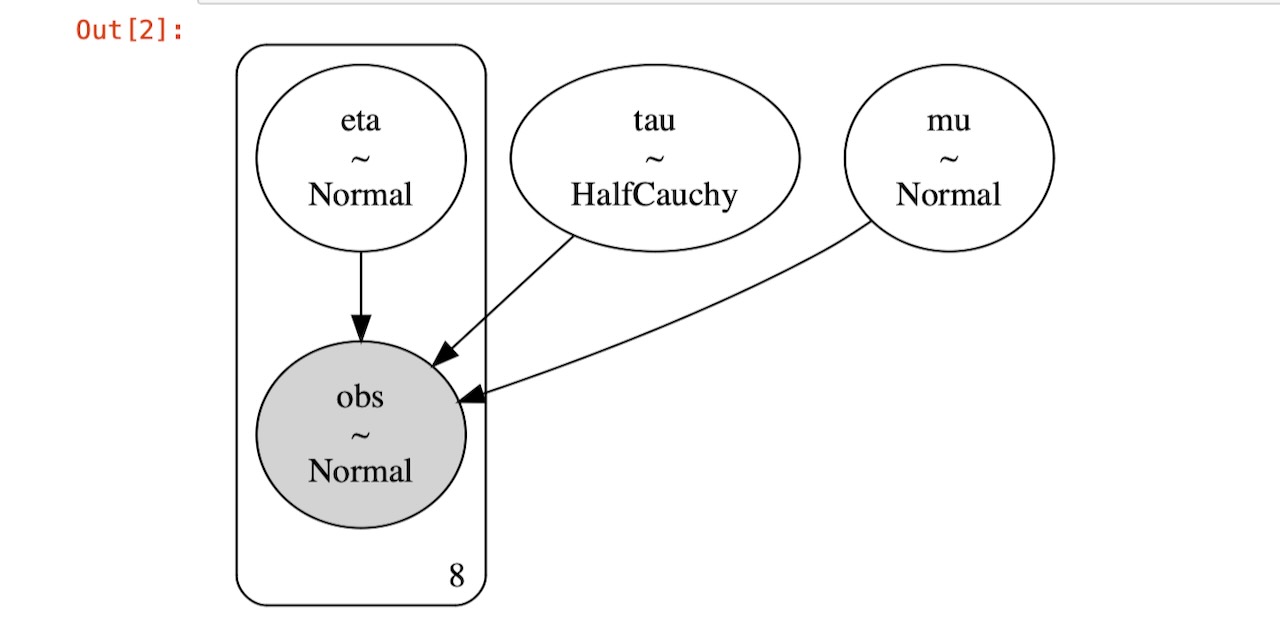モデル
| モデルの生成、検定 | ||
| Model(*args,**kwargs) | モデルの変数と尤度因子をカプセル化 | |
| model_to_graphviz([model,var_names,formatting]) | graphviz図を生成 | |
| model_to_networkx([model,var_names,formatting]) | netwokxのダイグラフを生成 | |
| modelcontext(model) | モデルのコンテキストを返す。 |
| その他 | ||
| Deterministic(name,var[,model,dims]) | 定数 | |
| Potential(name,var[,model,dims]) | モデルの尤度に任意の因子を追加する | |
| set_data(new_data[,model,coords]) | 変数にデータを設定 | |
| Point(*args[,filter_model_vars]) | ポイントを生成 | |
| compile_fn(outs,*[,inputs,mode,...]) | PyTensor関数をコンパイル |
Model
モデルの変数と尤度因子をカプセル化する
class pymc.Model(*args, **kwargs)(使用例)
class CustomModel(Model):
# 1) override init
def __init__(self, mean=0, sigma=1, name=''):
# 2) call super's init first, passing model and name
# to it name will be prefix for all variables here if
# no name specified for model there will be no prefix
super().__init__(name, model)
# now you are in the context of instance,
# `modelcontext` will return self you can define
# variables in several ways note, that all variables
# will get model's name prefix
# 3) you can create variables with the register_rv method
self.register_rv(Normal.dist(mu=mean, sigma=sigma), 'v1', initval=1)
# this will create variable named like '{name::}v1'
# and assign attribute 'v1' to instance created
# variable can be accessed with self.v1 or self['v1']
# 4) this syntax will also work as we are in the
# context of instance itself, names are given as usual
Normal('v2', mu=mean, sigma=sigma)
# something more complex is allowed, too
half_cauchy = HalfCauchy('sigma', beta=10, initval=1.)
Normal('v3', mu=mean, sigma=half_cauchy)
# Deterministic variables can be used in usual way
Deterministic('v3_sq', self.v3 ** 2)
# Potentials too
Potential('p1', pt.constant(1))
# After defining a class CustomModel you can use it in several
# ways
# I:
# state the model within a context
with Model() as model:
CustomModel()
# arbitrary actions
# II:
# use new class as entering point in context
with CustomModel() as model:
Normal('new_normal_var', mu=1, sigma=0)
# III:
# just get model instance with all that was defined in it
model = CustomModel()
# IV:
# use many custom models within one context
with Model() as model:
CustomModel(mean=1, name='first')
CustomModel(mean=2, name='second')
# variables inside both scopes will be named like `first::*`, `second::*`model_to_graphviz
PyMCモデルからGraphviz図を生成する。
| 変数 | 型 | |
| model | プロットするモデル | |
| var_names | プロットする変数のサブセット | |
| formatting | str |
図を表示させるためにはgraphvizをインストールしておく必要があります。condaパッケージマネージャーを使用する場合
conda install -c conda-forge python-graphviz(使用例)
import numpy as np
from pymc import HalfCauchy, Model, Normal, model_to_graphviz
J = 8
y = np.array([28, 8, -3, 7, -1, 1, 18, 12])
sigma = np.array([15, 10, 16, 11, 9, 11, 10, 18])
with Model() as schools:
eta = Normal("eta", 0, 1, shape=J)
mu = Normal("mu", 0, sigma=1e6)
tau = HalfCauchy("tau", 25)
theta = mu + tau * eta
obs = Normal("obs", theta, sigma=sigma, observed=y)
model_to_graphviz(schools)以下の図は上記コードを実行した出力です。

model_to_networkx
PyMCモデルからnetworkx図を生成する。
pymc.model_to_networkx(model=None, *, var_names=None, formatting='plain')図を表示させるためには、networkxをインストールしておく必要があります。condaパッケージマネージャーを使う場合は、
conda install networkxpipでインストールする場合は、
pip install networkx| 変数 | 型 | |
| model | プロットするモデル | |
| var_names | プロットする変数のサブセット | |
| formatting | str |
(使用例)
import numpy as np
from pymc import HalfCauchy, Model, Normal, model_to_networkx
J = 8
y = np.array([28, 8, -3, 7, -1, 1, 18, 12])
sigma = np.array([15, 10, 16, 11, 9, 11, 10, 18])
with Model() as schools:
eta = Normal("eta", 0, 1, shape=J)
mu = Normal("mu", 0, sigma=1e6)
tau = HalfCauchy("tau", 25)
theta = mu + tau * eta
obs = Normal("obs", theta, sigma=sigma, observed=y)
model_to_networkx(schools)modelcontext
与えられたモデルを返します。
pymc.modelcontext(model)